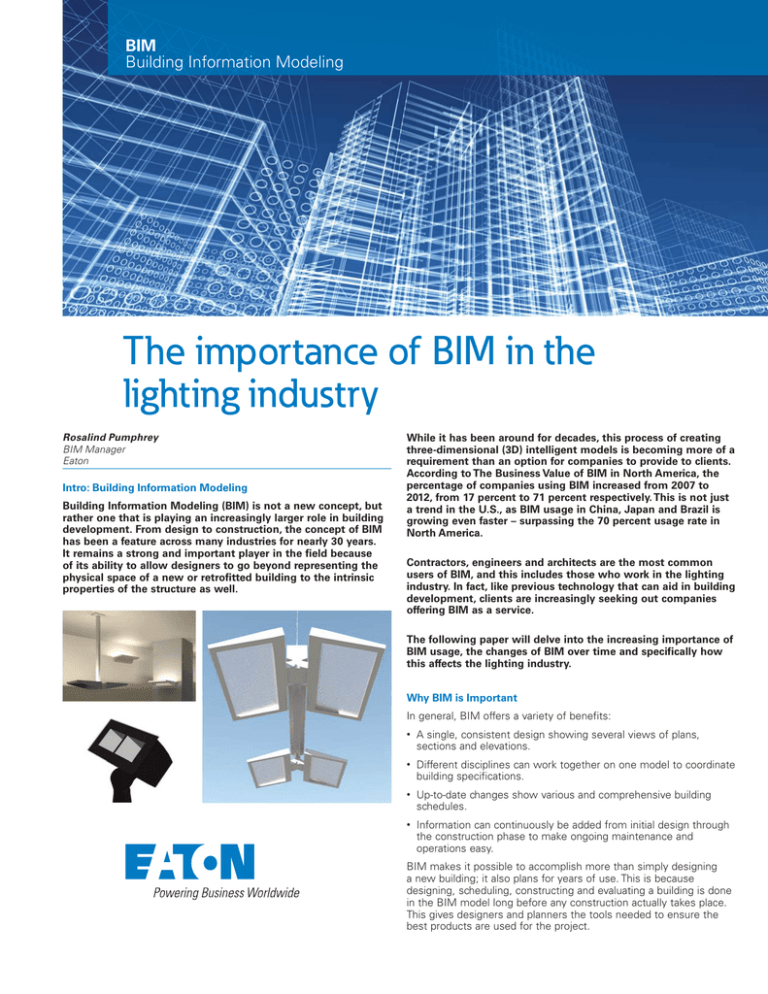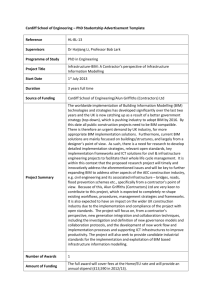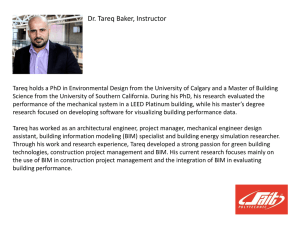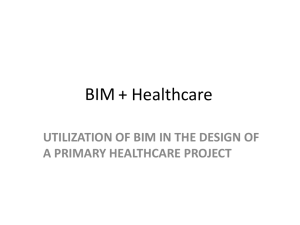
BIM
Building Information Modeling
The importance of BIM in the
lighting industry
Rosalind Pumphrey
BIM Manager
Eaton
Intro: Building Information Modeling
Building Information Modeling (BIM) is not a new concept, but
rather one that is playing an increasingly larger role in building
development. From design to construction, the concept of BIM
has been a feature across many industries for nearly 30 years.
It remains a strong and important player in the field because
of its ability to allow designers to go beyond representing the
physical space of a new or retrofitted building to the intrinsic
properties of the structure as well.
While it has been around for decades, this process of creating
three-dimensional (3D) intelligent models is becoming more of a
requirement than an option for companies to provide to clients.
According to The Business Value of BIM in North America, the
percentage of companies using BIM increased from 2007 to
2012, from 17 percent to 71 percent respectively. This is not just
a trend in the U.S., as BIM usage in China, Japan and Brazil is
growing even faster – surpassing the 70 percent usage rate in
North America.
Contractors, engineers and architects are the most common
users of BIM, and this includes those who work in the lighting
industry. In fact, like previous technology that can aid in building
development, clients are increasingly seeking out companies
offering BIM as a service.
The following paper will delve into the increasing importance of
BIM usage, the changes of BIM over time and specifically how
this affects the lighting industry.
Why BIM is Important
In general, BIM offers a variety of benefits:
•
A single, consistent design showing several views of plans,
sections and elevations.
•
Different disciplines can work together on one model to coordinate
building specifications.
•
Up-to-date changes show various and comprehensive building
schedules.
•
Information can continuously be added from initial design through
the construction phase to make ongoing maintenance and
operations easy.
BIM makes it possible to accomplish more than simply designing
a new building; it also plans for years of use. This is because
designing, scheduling, constructing and evaluating a building is done
in the BIM model long before any construction actually takes place.
This gives designers and planners the tools needed to ensure the
best products are used for the project.
By entering information about the lighting fixtures used, such as the
type, size and photometric data, to name a few, users can perform
an energy analysis for simulation through the software. This can
help clients make more informed decisions about the fixtures they
choose for their space. Additionally, BIM has the ability to render
engines, specify taxonomy, and create model components which
gives users the opportunity to view the entire 3D representation, as
well as sections of the model.
BIM is also able to provide real-time coordination between
industries, which makes it possible to see how other team members
working on the project are changing and adapting their tasks and
how it affects lighting design. This makes it easier in the long run
to make choices and finalize decisions earlier in the design process
than traditional methods.
This relative ease of lighting design makes BIM even more
functional for users. Designers are given the rendering tools needed
to complete model visualization and energy assessments sooner
and more easily than ever before.
Little BIM vs. Big BIM
There is a distinction that needs to be made between a Building
Information Model and Building Information Modeling. These two are
sometimes also referred to as Little BIM and Big BIM.
While the model itself is called a Building Information Model, the
continued use after the building’s construction has been completed
is called Building Information Modeling. This means that once the
building is occupied, the process of modeling continues to keep
building operations going.
To put more simply, a Building Information Model (Little BIM) is used
to develop a new building while Building Information Modeling (Big
BIM) is a representation that continues to monitor the structure after
it has been completed.
The first option is level-based, which make the fixtures independent
of any changes in the architecture. For instance, if the height of a
wall changes, the location and height of the corresponding fixture
remains in its original position.
The second and most preferred option is face-based, which makes
the fixtures dependent upon the architecture, even if it’s a linked
model. An example here would be if a wall were shifted to a new
location in the model. In a face-based approach, all the associated
lighting fixtures would move in conjunction.
Daylighting
An important consideration when planning lighting design is
daylighting. By looking at how much natural light is coming into a
space, designers can better plan for artificial lighting. Light from
windows, glazed openings and skylights can be utilized to create
a more aesthetically pleasing space and should be coordinated
with internal lighting fixtures as well as synchronizing artificial
lighting fixtures. With the ability to measure natural light in a BIM
model, designers can make decisions based on daylighting, such
as installing dimmable fixtures, ballasts and controls to supplement
incoming light.
Using Building Information Modeling in Facilities Management
As mentioned previously, Big BIM is the process of monitoring a
structure post-occupancy. In this way, BIM can be a useful tool that
goes beyond acting as a simple representation of a building to an
active player in keeping the structure operating smoothly.
By utilizing BIM to aid in building operations through Integrated
Project Delivery (IPD) – an approach integrating people, systems
and businesses – facility managers are better able to take a more
interactive, virtual approach to building management.
Because of this integrated information, BIM can continue to provide
useful information and data throughout the life of the building This
means the data of the expected lighting and energy performance
can be compared to the data showing the actual lighting
performance and energy consumption over time. This is a valuable
tool for facilities management and may help them decide whether
to keep the building operating as is or figure out how things can or
should be altered.
Looking to the Future
BIM and the Lighting Industry
It is common knowledge that when designing a building, the lighting
of the new or retrofitted structure needs to be taken into account.
As the budgets of firms continue to shrink and project deadlines
need to be coordinated with always-evolving technology and stricter
government policies, it is becoming increasingly important to offer
advanced options. This includes providing energy- and cost-efficient
lighting choices that maintain a high level of quality.
In order to give firms what they desire, BIM allows lighting
professionals the ability to carefully consider where and how many
light fixtures will be placed during the preliminary design stage. As
more specifics are decided upon, further information can be added
to the model, such as lighting values of light switches, daylight
sensors and occupancy sensors, as well as any additional recessed,
suspended or surface mounted lights.
Level-based or Face-based
There are multiple locations within a BIM model where fixtures can
be placed or hosted, including the wall, ceiling and floor. With these
placements, there are two options used for a light fixture model.
EATON
BIM - Building Information Modeling
Because BIM software and technology continues to grow and
become adopted by more architects, design-build firms, contractors,
surveyors, engineers and others, there are several large-scale
building projects and clients using BIM. For instance, the Freedom
Tower in New York City, the Sydney Opera House retrofit in Australia
and the U.S. General Services Administration all used Building
Information Modeling software for design and operational purposes.
While there have been a plethora of advancements in BIM software
over the years, it is important to note that nothing can replace the
knowledge and expertise of a trained lighting professional. However,
as building designs are becoming increasingly intricate and complex,
the need for BIM will only increase. To ensure clients are getting
the ideal amount of the correct style of lighting prior to installation,
professionals in the lighting industry will soon be expected to be
well-versed in BIM modeling, capabilities and services.
To help designers throughout the planning process, Eaton offers BIM
models for more of its products than any other lighting manufacturer.
These BIM models are filled with intelligent information and data in
order to provide seamless integration of Eaton’s lighting products
into designs easily and without cost.
Making intelligent content easily accessible to the entire design
team, BIM provides revisions early in the lighting design phase.
Implementing BIM enhances the outcome of projects big and small,
and as the technology becomes more common, it will only become
more powerful and advanced. Eaton’s investment in a professional
staff to develop and support BIM models is just one example of the
company’s commitment to being the lighting industry BIM leader.
Eaton’s BIM-friendly models are created in Autodesk Revit and are
compatible with multiple CAD formats, Bentley AECsim Building
Designer (via Bentley RFA Interpreter) and others.
Eaton delivers a range of innovative and reliable indoor and outdoor
lighting solutions, and it controls products specifically designed to
maximize performance, energy efficiency and cost savings. The
lighting business division serves customers in the commercial,
industrial, retail, institutional, residential, utility and other markets.
For more information, visit ww.Eaton.com/Lighting.
Eaton’s Electrical Sector is a global leader with expertise in power
distribution and circuit protection; backup power protection; control
and automation; lighting and security; structural solutions and wiring
devices; solutions for harsh and hazardous environments; and
engineering services. Eaton is positioned through its global solutions
to answer today’s most critical electrical power management
challenges.
Eaton is a power management company with 2013 sales of $22.0
billion. Eaton provides energy-efficient solutions that help customers
effectively manage electrical, hydraulic and mechanical power more
efficiently, safely and sustainably. Eaton has approximately 103,000
employees and sells products to customers in more than 175
countries. For more information, visit www.eaton.com.
References
•
A Brief History of BIM. Michael S. Bergin. Dec. 2012.
•
Autodesk Education Community. Autodesk. n.d.
•
BIM in 10 Lessons. John Hill. Feb. 2013
•
The Business Value of BIM in North America: Multi-Year Trend
Analysis and User Ratings SmartMarket Report. McGraw-Hill
Construction. 2012.
•
Building Information Modeling and Lighting Design. James Bates
and Kenz Meliani. Jan. 2013.
•
The Future of Construction: Meet BIM (Or Else). C.C. Sullivan.
Feb. 2013.
•
Integrated Project Kelivery: A Guide. The American Institute of
Architects. 2007.
Eaton
1121 Highway 74 South
Peachtree City, GA 30269
P: 770-486-4800
ww.eaton.com/lighting
© 2015 Eaton
All Rights Reserved
Printed in USA
Publication No. WP519001EN
May 2015
Eaton is a registered trademark.
All other trademarks are property
of their respective owners.
Follow us on social media to get the
latest product and support information.







